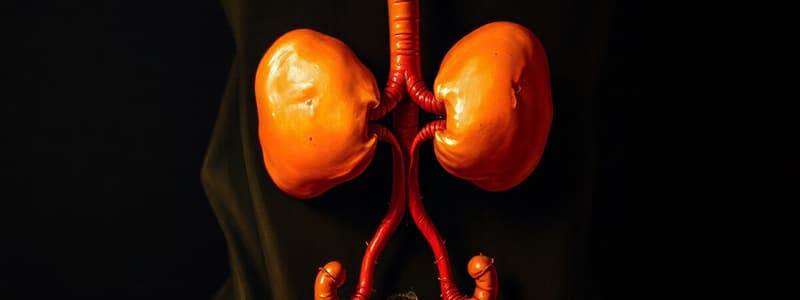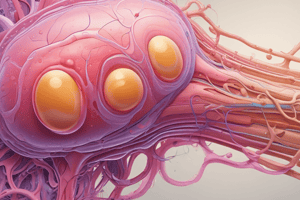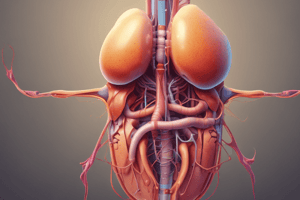Podcast
Questions and Answers
Which urine characteristic indicates a healthy individual?
Which urine characteristic indicates a healthy individual?
- Cloudy with visible particles, pH of 9
- Reddish tint, strong ammonia smell
- Transparent yellow, odorless (correct)
- Malodorous appearance, dark amber
A patient's urinalysis reveals the presence of glucose. This finding is most suggestive of:
A patient's urinalysis reveals the presence of glucose. This finding is most suggestive of:
- Dehydration
- Kidney stones
- Poorly controlled diabetes (correct)
- Urinary tract infection
What range defines normal urine specific gravity?
What range defines normal urine specific gravity?
- 1.050-1.070
- 1.035-1.045
- 0.990-1.000
- 1.003-1.030 (correct)
A patient presents with elevated BUN and normal creatinine levels. What is the most likely cause?
A patient presents with elevated BUN and normal creatinine levels. What is the most likely cause?
An order for a 24-hour urine collection has been received. Which instruction is MOST crucial to relay to the patient?
An order for a 24-hour urine collection has been received. Which instruction is MOST crucial to relay to the patient?
A patient scheduled for an intravenous pyelogram (IVP) should be assessed for allergy to:
A patient scheduled for an intravenous pyelogram (IVP) should be assessed for allergy to:
What does an elevated Prostate Specific Antigen (PSA) level potentially indicate?
What does an elevated Prostate Specific Antigen (PSA) level potentially indicate?
A renal angiography is performed using the right femoral artery. Post procedure, a primary nursing intervention will include which of the following?
A renal angiography is performed using the right femoral artery. Post procedure, a primary nursing intervention will include which of the following?
Which type of catheter is specifically used to ease past an enlarged prostate?
Which type of catheter is specifically used to ease past an enlarged prostate?
Which of these post-cystoscopy parameters are of most concern to the nurse?
Which of these post-cystoscopy parameters are of most concern to the nurse?
What is a primary consideration when caring for a patient undergoing a renal scan?
What is a primary consideration when caring for a patient undergoing a renal scan?
Prior to a transrectal ultrasound, nurses should ensure this is completed:
Prior to a transrectal ultrasound, nurses should ensure this is completed:
A patient has an order for an MRI of the abdomen. Which of the following is most important to assess prior to the test?
A patient has an order for an MRI of the abdomen. Which of the following is most important to assess prior to the test?
Which statement best describes a urodynamic study?
Which statement best describes a urodynamic study?
Following percutaneous renal biopsy, what instructions should be given to the patient?
Following percutaneous renal biopsy, what instructions should be given to the patient?
A patient's urine output has consistently been 500 mL per day with a documented fluid intake of 2 liters. Which of the following factors is LEAST likely to cause this discrepancy?
A patient's urine output has consistently been 500 mL per day with a documented fluid intake of 2 liters. Which of the following factors is LEAST likely to cause this discrepancy?
A patient's urinalysis reveals the presence of erythrocytes, but the patient denies any urinary complaints. Which of the following conditions is LEAST likely to be the cause?
A patient's urinalysis reveals the presence of erythrocytes, but the patient denies any urinary complaints. Which of the following conditions is LEAST likely to be the cause?
A 75-year-old female patient has been experiencing stress incontinence. Which physiological change associated with aging is MOST likely contributing to this condition?
A 75-year-old female patient has been experiencing stress incontinence. Which physiological change associated with aging is MOST likely contributing to this condition?
A patient's specific gravity reading is 1.035. Which of the following is MOST important for the nurse to assess?
A patient's specific gravity reading is 1.035. Which of the following is MOST important for the nurse to assess?
A patient’s BUN is 40 mg/dL and creatinine is 1.5 mg/dL. The nurse recognizes this as MOST indicative of:
A patient’s BUN is 40 mg/dL and creatinine is 1.5 mg/dL. The nurse recognizes this as MOST indicative of:
A patient undergoing a 24-hour urine collection accidentally voids the first sample into the toilet. What is the MOST appropriate nursing action?
A patient undergoing a 24-hour urine collection accidentally voids the first sample into the toilet. What is the MOST appropriate nursing action?
A patient is scheduled for a renal scan. Which of the following statements best describes how the imaging works?
A patient is scheduled for a renal scan. Which of the following statements best describes how the imaging works?
A patient requires a catheter insertion due to urethral trauma. Which type of catheter is MOST appropriate considering the circumstances?
A patient requires a catheter insertion due to urethral trauma. Which type of catheter is MOST appropriate considering the circumstances?
During a retrograde urethrography, the nurse would expect the radiopaque dye to be injected into which location?
During a retrograde urethrography, the nurse would expect the radiopaque dye to be injected into which location?
A patient is undergoing a renal angiography. Following the procedure, the nurse notes that the patient's pedal pulses are diminished in the affected limb. Which statement is the best approach from the nurse?
A patient is undergoing a renal angiography. Following the procedure, the nurse notes that the patient's pedal pulses are diminished in the affected limb. Which statement is the best approach from the nurse?
Flashcards
Normal urine output
Normal urine output
The normal volume of urine excreted by a healthy adult in a day.
Urine Formation
Urine Formation
The process of removing waste products from the blood and forming urine.
Water in urine
Water in urine
The primary component of urine, accounting for 95% of its volume.
Hematuria
Hematuria
Signup and view all the flashcards
Glucose in urine
Glucose in urine
Signup and view all the flashcards
Leukocytes in urine
Leukocytes in urine
Signup and view all the flashcards
Decreased kidney filtration with age
Decreased kidney filtration with age
Signup and view all the flashcards
Stress incontinence
Stress incontinence
Signup and view all the flashcards
Catheterization
Catheterization
Signup and view all the flashcards
Urinalysis (UA)
Urinalysis (UA)
Signup and view all the flashcards
Specific gravity
Specific gravity
Signup and view all the flashcards
Intravenous Pyelogram (IVP)
Intravenous Pyelogram (IVP)
Signup and view all the flashcards
Cystoscopy
Cystoscopy
Signup and view all the flashcards
Urodynamic study
Urodynamic study
Signup and view all the flashcards
Foley catheter
Foley catheter
Signup and view all the flashcards
Urine composition
Urine composition
Signup and view all the flashcards
Urine pH range
Urine pH range
Signup and view all the flashcards
Urinary bladder capacity
Urinary bladder capacity
Signup and view all the flashcards
Hematuria causes
Hematuria causes
Signup and view all the flashcards
Kidney function with age
Kidney function with age
Signup and view all the flashcards
Prostate-specific antigen (PSA)
Prostate-specific antigen (PSA)
Signup and view all the flashcards
BUN and creatinine relationship
BUN and creatinine relationship
Signup and view all the flashcards
Osmolality test
Osmolality test
Signup and view all the flashcards
Urodynamic study purpose
Urodynamic study purpose
Signup and view all the flashcards
Study Notes
Urinary System Basics
- Normal urine output: 1-2 liters per day
- Factors influencing urine output: fluid intake, physical activity, blood pressure, meal intake, sweating
- Composition: 95% water, 5% waste products (nitrogenous waste and salts)
- Appearance: transparent yellow, lighter color with increased fluid intake, odorless but not malodorous
- pH: 4.6 - 8
- Urinary bladder capacity: 750-1000 mL, urge to urinate starts around 2-4 liters
- Sterility: Healthy urine is sterile
Urine Abnormalities
- Hematuria: Blood in urine, can indicate infection, tumors, kidney disease or kidney stones
- Glucose: Sugar in urine, indicates high blood glucose levels, often seen in diabetes
- Erythrocytes: Red blood cells in urine, can indicate infection, tumors, kidney disease, or kidney stones
- Ketone bodies: Excessive quantities of fatty acids broken down for fuel, not normal, typically seen in diabetic ketoacidosis (DKA), starvation, or other metabolic conditions
- Leukocytes: White blood cells in urine, indicates urinary tract infection
Aging and the Urinary System
- Decreased filtering efficiency by age 70: ~50% of efficiency compared to age 40
- Reasons for decreased efficiency: decreased blood supply, loss of nephrons
- Female bladder: Loss of tone, perineal muscles may relax leading to stress incontinence
- Males: Enlarged prostate gland can obstruct urethra, leading to restricted urine flow
Lab and Diagnostic Exams
- Urinalysis (UA): Voided or catheterized sample
- Culture and Sensitivity (C&S): Performed if UA is positive, identifies organism and appropriate treatment medications
- Specific gravity: Measures hydration status and kidney's ability to concentrate urine, normal range: 1.003-1.030
- 24-hour Urine Collection: First urine sample is discarded, all subsequent urine is collected, kept on ice, sent to lab
- Blood Urea Nitrogen (BUN): Elevated with dehydration, usually tested with creatinine
- BUN Elevated, Creatinine Normal: Suggests dehydration
- BUN Elevated, Creatinine Elevated: Suggests kidney disease
- Normal BUN: 10-20 mg/dL
- Serum Creatinine: Measures impaired renal function, usually tested with BUN
- Normal Serum Creatinine: 0.5-1.2 mg/dL
- Elevated Serum Creatinine: Suggests overload, nephritis, pyelonephritis, acute tubular necrosis, urinary obstruction
- Lower serum creatinine: Suggests myasthenia gravis or late-stage muscular dystrophy
- Creatinine Clearance: Measures GFR (glomerular filtration rate) over 24 hours
- Increased Serum Creatinine, Decreased Urine Creatinine: Indicates kidney disease
- Normal Serum Creatinine: 0.5-1.2 mg/dL
- Normal Urine Creatinine: 107-139 mL/min (males), 87-107 mL/min (females)
- Prostate Specific Antigen (PSA): Blood sample taken before prostate exam
- Normal PSA: Less than 4 ng/mL
- Elevated PSA: Can indicate prostate cancer, benign prostatic hyperplasia (BPH), or other issues
- Osmolality: Measures kidney's ability to concentrate urine
- Kidney, Ureter, Bladder Radiography (KUB): Assesses general abdominal status and evaluates urinary tract structures, no pre-procedure prep required
- Intravenous Pyelogram (IVP): Evaluates urinary tract structures, filling of renal pelvis with urine, and transport of urine via ureters to bladder
- IVP Preparation: Light supper, non-gas forming laxative, NPO for 8 hours
- IVP Considerations: Assess allergies to iodine or iodine-containing foods
- Retrograde Urography: Radiopaque dye injected into ureters to visualize upper urinary tract
- Retrograde Cystogram: Dye injected into bladder
- Retrograde Urethrography: Dye injected into urethra
- Voiding Cystourethrogram: Detects abnormalities of bladder or urethra, catheter inserted into bladder, dye injected, x-rays taken
- Cystoscopy: Scope with lighting source inserted into urethra to visualize bladder and surrounding structures
- Cystoscopy Post-Procedure: Assess for hematuria
- Renal Angiography: Radiopaque catheter inserted into artery (femoral artery) to evaluate blood supply to kidneys, assess for masses, detect complications after kidney transplant
- Renal Angiography Preparation: NPO past midnight
- Renal Angiography Post-Procedure: Assess puncture site for bleeding, keep patient flat with pressure dressing intact, monitor circulatory status
- Renal Venogram: Uses femoral vein to evaluate kidneys' venous drainage, monitor puncture site, vital signs, and pulses
- Computed Tomography (CT) Scan: With or without contrast, assesses size, masses, cysts
- Magnetic Resonance Imaging (MRI): Provides greater detail than CT, remove metal objects, patients with metal implants cannot have MRI
- Renal Scan: Radio nucleotide tracer injected, taken up by renal tubular cells, excreted by glomerular filtrate, computer images assess blood flow and GFR
- Renal Scan Considerations: Pregnant nurses cannot care for patients due to radiation exposure
- Ultrasound: Assesses size of kidney, ureters, bladder, masses, cysts
- Transrectal Ultrasound: Provides image of prostate tumors, guides biopsies
- Renal Biopsy: Open or needle (percutaneous) biopsy
- Open Biopsy: Surgical incision
- Needle Biopsy: Needle insertion
- Renal Biopsy Post-Procedure: Bedrest with bathroom privileges for 24 hours, gradually resume activities after 48-72 hours
- Urodynamic Study: Evaluates detrusor reflex, catheter inserted into bladder, measures bladder capacity and pressure
- Urodynamic Study Procedure: Patient reports sensations of heat, cold, and urge to void, positions may be changed, medications may be administered
- Foley Catheter: Balloon near tip inflates to hold catheter in urinary bladder
- Coude Catheter: Tapered tip, less flexible, eases past enlarged prostate
- Malecot (Mushroom) Catheter: Drains urine from kidney's renal pelvis, inserted by doctor
- Robinson Catheter: Multiple openings in tip for intermittent drainage
- Ureteral Catheter: Long and slender, goes past bladder into ureters
- Whistle-Tip Catheter: Slanted, larger orifice, used if blood is present
- Suprapubic Catheter: Inserted through abdominal wall above symphysis pubis, diverts urine flow from urethra, often used for injury, bony pelvis issues, tumor obstructions, etc.
- Condom Catheter: Non-invasive, external, provides drainage
- Self Catheterization: Clean technique, used for spinal cord injury or neurological disorders, patient must be instructed on signs and symptoms of infection
- Bladder Training: Develops perineal muscle control to improve voiding
- Clamp Unclamp Routine: Helps improve bladder tone
- Stress Incontinence: Exercises perineal muscles to stop urine flow (Kegel exercises)
- Habit Training: Monitors voiding patterns and schedules toileting to prevent incontinence
- Habit Training Considerations: Fluid intake and medications impacting output must be considered
Studying That Suits You
Use AI to generate personalized quizzes and flashcards to suit your learning preferences.



